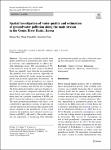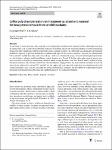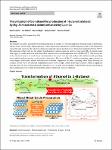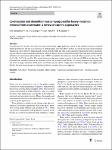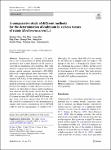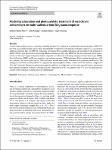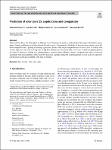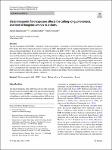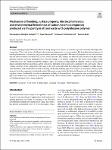Search
Author
- Osman, Ahmed I. (5)
- Chen, Zhonghao (2)
- Ricohermoso III, Emmanuel (2)
- Wang, Yongbin (2)
- next >
Subject
- LCA (6)
- ICP-MS (3)
- Artificial intelligence (2)
- CDW (2)
- next >
Date issued
Has File(s)
- true (220)
Search Results
This study aims to identify spatially water quality distribution of groundwater and surface water in reservoirs, and comprehensively to address possible influencing factors. The concentration of NO3 in the reservoirs along the main stream of the Geum River was generally lower than that in groundwater. The pollution level of the reservoir, especially the particulate pollutant SS, clearly showed seasonal variations and increased significantly downstream. The H-3 concentration of the groundwater was high in the plains and low in the mountain areas, indicating a difference in residence time between the two regions. The hydrochemical properties and factor loading values of the principal components indicated that the major factors were water‒rock interactions and residence time, but a pos... |
To add value to wastes from the coffee crop, this research physically and chemically characterized the coffee pulp waste from an organic farm crop located in Santa Bárbara (Antioquia-Colombia), specifically analyzing whether or not this material has promise for heavy metal removal from wastewater, such as landfill leachate. The coffee pulp was chemically and thermally modified to improve its physical and chemical condition and improve the sorption capacities. Sorption was characterized before and after modification thus point of zero charge, surface area, functional groups, elemental and morphological analysis, and its lignin, cellulose, and hemicellulose content. |
The Guerbet reaction is a possible way for transformation of ethanol to 1-butanol (important for many kinds of industries), which consists of four steps: dehydrogenation, aldol condensation, dehydration, and hydrogenation. Due to the elimination of possible side-reactions, the selective catalysis is required to favour production of 1-butanol at temperature below 350 °C. The main aim of this work was the ethanol transformation via heterogeneous catalysis using active Mg–Al mixed oxides with copper or cobalt carried out in the microflow reactor in the reaction temperature interval 280–350 °C. The novelty lies in the statistical analysis of results from characterization of catalyst structure and surface with catalysis results providing more sophisticated perspective on the ethanol valo... |
Over the past few decades, the world is facing critical water supply problems caused by the relentless increase of global human populations and the associated rise of anthropogenic activities. Heavy metals are among the main water pollutants which pose a great threat to human health. Hence, globally there has been a large amount of research devoted to investigating cost-effective and sustainable methods for removal of heavy metals from polluted water. One such area of interest is the utilization of construction and demolition waste (CDW) materials for the adsorptive removal of heavy metal ions (As, Cd, Co, Cr, Cu, Hg, Ni, Pb, Sr, and Zn). This review focuses on the most current research for the use of CDW as an adsorbent. The different heavy metal ion removal mechanisms involved are... |
Remediation of cadmium (Cd) pollution is one of the priorities of global environmental governance and accurate detection of Cd content is a key link in remediation of Cd pollution. This study aimed to compare three methods (inductively coupled plasma optical emission spectrometry (ICP-OES), inductively coupled plasma mass spectrometry (ICP-MS), and graphite furnace-atomic absorption spectrometry (GF-AAS)) for the determination of Cd with different tissues of various ramie varieties, and distinguish the advantage and disadvantage of each method. In total, 162 samples of ramie (Boehmeria nivea L.), which is an ideal plant for heavy metal remediation, were detected and the results showed that the three methods were all suitable for the de-termination of Cd content in ramie. ICP-OES and... |
A nanocomposite photocatalyst consisting of titanium dioxide (TiO2) supported on multiwalled carbon nanotubes (MWCNTs) has been successfully prepared and used for the treatment of wastewater contaminated with tetracycline (TC), a recalcitrant antibiotic pollutant. The TiO2/MCNT composites were prepared by a simple evaporation-drying method. The properties of MWCNT/TiO2 were optimized by dispersing different amounts of TiO2 onto MWCNT. The structural and optical characteristics of the nano-engineered photocatalyst composite were characterized using scanning electron microscopy (SEM), X-ray diffraction (XRD), and Fourier-transform infrared spectroscopy (FTIR) techniques. Photocatalytic degradation of TC was conducted in a quartz glass reactor. |
Solar activity affects the heliosphere in different ways. Variations in particles and radiation that impact the Earth’s atmosphere, climate, and human activities often in disruptive ways. Consequently, the ability to forecast solar activity across different temporal scales is gaining increasing significance. In this study, we present predictions for solar cycle 25 of three solar activity indicators: the core-to-wing ratio of Mg II at 280 nm, the solar radio flux at 10.7 cm—widely recognized proxies for solar UV emission—and the total solar irradiance, a natural driver of Earth’s climate. Our predictions show a very good agreement with measurements of these activity indicators acquired during the ascending phase of solar cycle 25, representing the most recent data available at the ti... |
The number and diversity of phenological studies has increased rapidly in recent years. Innovative experiments, field studies, citizen science projects, and analyses of newly available historical data are contributing insights that advance our understanding of ecological and evolutionary responses to the environment, particularly climate change. However, many phenological data sets have peculiarities that are not immediately obvious and can lead to mistakes in analyses and interpretation of results. This paper aims to help researchers, especially those new to the field of phenology, understand challenges and practices that are crucial for effective studies. |
The electromagnetic field (EMF) is ubiquitous in the environment, constituting a well-known but poorly understood stressor. Few studies have been conducted on insect responses to EMF, although they are an excellent experimental model and are of great ecological importance. In our work, we tested the effects of EMF (50 Hz, 7 mT) on the cricket Gryllus bimaculatus: the male calling song pattern, female mate choice, and levels of biogenic amines in the brain. Exposure of males to EMF increased the number and shortened the period of chips in their calling song (by 2.7% and 5% relative to the control song, respectively), but not the sound frequency. Aged (3-week-old) females were attracted to both natural and EMF-modified male signals, whereas young (1-week-old, virgin) females responded... |
A simple mixing-pressing followed by thermal curing and pyrolysis process was used to upcycle coal waste into high-value composites. Three coal wastes of different physicochemical properties were investigated. The hypothetical mechanisms of bonding between the coal particles and the preceramic polymer are presented. The textural properties of the coals indicated that the lowest volatile coal waste (PCD) had a dense structure. This limited the diffusion and reaction of the preceramic polymer with the coal waste during pyrolysis, thereby leading to low-quality composites. The water contact angles of the composites up to 104° imply hydrophobic surfaces, hence, no external coating might be required. Analysis of the carbon phase confirmed that the amorphous carbon structure is prevalent ... |

